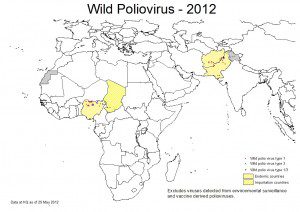

The likeliness of polio virus being exported to India from Pakistan is very low, and historically, it has not happened. Those who travel from India to Pakistan are mostly adults. There are rarely any babies. So the chances are low.
It is correct that polio has not traveled from Pakistan to India during the modern era of virus detection (1980 to the present). However, the same genotypes of types 1 and 3 poliovirus have circulated in both countries, implying sharing of viruses some time in recent history. Therefore Ali cannot conclude that export of virus to India ‘has not happened’.
Poliovirus continues to circulate in Pakistan, which shares a border with India: there were 198 cases in that country in 2011, the most of any in the world, and 16 cases so far in 2012. Remember that most poliovirus infections are asymptomatic, so the number of paralytic cases is far lower than the actual number of infections. The ratio of paralytic cases to infections varies according to the viral serotype: 1:200, 1:1800, and 1:1200 for types 1, 2, and 3 respectively. Furthermore, poliovirus has been known to spread from Pakistan from other countries. An outbreak of polio in Xinjiang, China, in 2011 was caused by virus imported from Sindh, Pakistan. There were 21 paralytic cases caused by poliovirus type 1, over half of which occurred in individuals 19-53 years old. The outbreak was halted by immunization but the region remains at risk for importation from Pakistan.
Poliovirus also continues to circulate in Afghanistan, which lies on the northwestern border of Pakistan. Eighty cases of paralytic disease were reported in this country in 2011, and 7 so far in 2012. It has been difficult to control polio in the southern provinces of Kandahar and Helmand due to ongoing armed activities. There is active migration between the southern regions of Afghanistan and Pakistan which has lead to a steady exchange of polioviruses between the two countries.
There many other examples of polio spread from one country to another in recent years. Following cessation of polio immunization in 2003, virus spread from Nigeria to many countries in Africa as well as to Indonesia. From India poliovirus has spread to Nepal, Angola (2005 and 2007), and Tajikistan and then to Russia (2010), in all cases causing substantial outbreaks of the disease.
The message is clear: poliovirus spreads easily among countries, and it is often spread by infected adults, not children. Because poliovirus infection is frequently asymptomatic, such spread cannot be detected by simply examining travelers for signs of paralysis.
For these reasons I am skeptical of Ali’s reassurance that the virus is not likely to spread from Pakistan to India. If adults mainly travel from India to Pakistan, as she says, they could well be infected and import the virus back home before it is detected. Furthermore, adults could bring the virus to India from other countries where poliovirus continues to circulate, although that is not Pakistan’s concern.
Because Pakistan remains a major reservoir of poliovirus, it is a good sign that the country is acknowledging the possibility that they might export the virus to India. The best way to avoid this scenario would be to intensify their immunization programs and eliminate the virus. Apparently Ali has been speaking with Indian officials to learn how they accomplished this goal:
We got to know what actually took India to become polio-free. We have understood the scale and efforts that we require to make Pakistan polio-free.

This is truly a remarkable achievement by India. I was personally involved in the Rotary ‘Eradicate Polio’ campaign in the late 90’s. The people to really thank are the grass roots NGOs and the awareness created by the government. Next stop – eradicate poverty.
By vaccination?
While your comment might be meant in a facetious manner, in fact removing the burden of infectious disease from the worlds poor would be a huge step towards alleviating poverty. It is difficult to learn and have a productive life in the face of constant infections. So I would say that yes, vaccination is one of the components of a program to eliminate poverty.
 Credit goes to the WHO-NPSP in India. With the help of 8 National Polio Labs in various hot spots in the country, the goal was achieved through routine surveillance of AFP cases coupled with extensive immunization programs. But as Dr Vincent had mentioned earlier, there is an urgent need to switch from OPVs to IPVs before India gets engulfed in a new epidemic caused by VDPVs.
I fully agree that infections and their consequences can be a great burden and should be prevented as efficient as possible but the chicken and egg question remains. Does immunization lead to less poverty or did higher economic growth lead to better healthcare and more immunization? A human with bad health will never be able to achieve what a healthy human can accomplish but especially when looking at Africa, I doubt that vaccination alone prevents poverty.Â
I think Dr.Vincent makes a great point above. Vaccination alone probably would not prevent poverty, but creates conditions where humans are free to pursue their dreams without being halted by a debilitating disease like polio. A recent study in the Economist shows just the mere act of restoring dignity to a person goes a long way in bringing people out of poverty. I think a good medical surveillance program equals restoring human dignity.
Pingback: The 100th birth anniversary of Jonas Salk